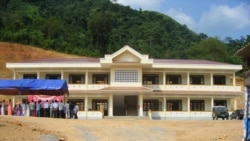Long before the Administration of President Barack Obama intensified U.S. cooperation with the Asia-Pacific region through the Rebalance policy, the U.S. Army Corps of Engineers was active throughout the region, working to help build infrastructure, to prepare for or mitigate natural disasters, and to share experience with host countries.
Speaking at the Foreign Press Center in Washington, Commanding General and Chief of Engineers for the U.S. Army Corps of Engineers Lieutenant General Thomas Bostick said that the Corps has been very active in the Asia-Pacific region for many years:
]"We execute a myriad of military construction, funded by the host nation construction, foreign military sales, humanitarian assistance, and disaster preparedness and response projects – in 22 countries in the Asia Pacific region, including the Republic of Korea, Japan, India, China, and Vietnam, to name a few.”
Recently, the Corps of Engineers helped to greatly improve the living conditions of impoverished families in Puttalam, Sri Lanka, by building a network of water supply pipes to their homes, saving them a 5 kilometer daily walk for potable water.
In Bangladesh, the Corps built twelve Coastal Crisis Management Centers, designed to provide cyclone refuge for 1,500 people, withstand an 8.0 earthquake and nearly 220 kilometer per hour winds. The structures are equipped with self-contained solar power generation and water facilities.
Since 2007, the Corps of Engineers has completed 34 projects in Vietnam, and is working on another 8, including the construction of schools, clinics and emergency centers.
And every year, the Corps of Engineer not only sends hundreds of people in response to disasters around the world; it also takes part in disaster preparedness activities such as the Pacific Resilience program, which helps localities across the Asia-Pacific region prepare for a variety of possible disasters such as earthquakes, cyclones, and floods.
“The U.S. Army Corps of Engineers continues to support the Asia Pacific region with a full range of planning, engineering, and design and construction management as well as technical assistance services,” said Lieutenant General Bostick. “We welcome the opportunities to work in the international community. We have ongoing work in 132 different countries, we’re physically present in over 40 countries, and we look forward to that continued partnership.”
Speaking at the Foreign Press Center in Washington, Commanding General and Chief of Engineers for the U.S. Army Corps of Engineers Lieutenant General Thomas Bostick said that the Corps has been very active in the Asia-Pacific region for many years:
]"We execute a myriad of military construction, funded by the host nation construction, foreign military sales, humanitarian assistance, and disaster preparedness and response projects – in 22 countries in the Asia Pacific region, including the Republic of Korea, Japan, India, China, and Vietnam, to name a few.”
Recently, the Corps of Engineers helped to greatly improve the living conditions of impoverished families in Puttalam, Sri Lanka, by building a network of water supply pipes to their homes, saving them a 5 kilometer daily walk for potable water.
In Bangladesh, the Corps built twelve Coastal Crisis Management Centers, designed to provide cyclone refuge for 1,500 people, withstand an 8.0 earthquake and nearly 220 kilometer per hour winds. The structures are equipped with self-contained solar power generation and water facilities.
Since 2007, the Corps of Engineers has completed 34 projects in Vietnam, and is working on another 8, including the construction of schools, clinics and emergency centers.
And every year, the Corps of Engineer not only sends hundreds of people in response to disasters around the world; it also takes part in disaster preparedness activities such as the Pacific Resilience program, which helps localities across the Asia-Pacific region prepare for a variety of possible disasters such as earthquakes, cyclones, and floods.
“The U.S. Army Corps of Engineers continues to support the Asia Pacific region with a full range of planning, engineering, and design and construction management as well as technical assistance services,” said Lieutenant General Bostick. “We welcome the opportunities to work in the international community. We have ongoing work in 132 different countries, we’re physically present in over 40 countries, and we look forward to that continued partnership.”

















